|
  
|
FROM SITE
SELECTION MAGAZINE, JANUARY 2022 ISSUE
|
 |
MIDWEST
How Grand Rapids plans to become a major tech hub in the central
U.S.
|
|
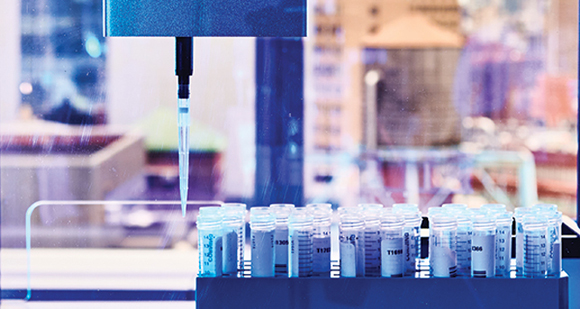 |
INVESTMENT PROFILE: NEW YORK CITY
Several factors have combined to foster a thriving center of life
sciences innovation, “all in a New York minute.”
|
|
|
CONWAY
ANALYTICS SNAPSHOT
|
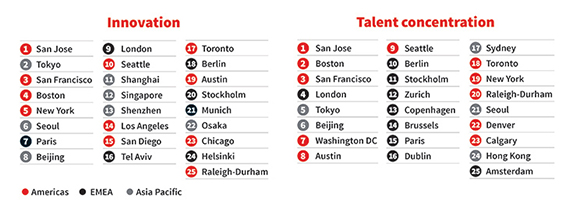
|
While the raw data are not available, JLL’s new Innovation Geographies report contains some
valuable insights when it comes to conclusions about corporate
occupancy costs in certain metro areas where costs have not yet
reached the sky. Locations such as Paris, Tokyo, San Francisco,
Barcelona, Paris, Beijing, London and Seoul still rank as “global
leaders,” says JLL. But “as people look for more affordable cities
that offer a better quality of life, markets that combine these
factors with a strong innovation ecosystem — like Denver, Stockholm
and Melbourne — are drawing in new companies and capital.”
JLL’s chart above shows the top 25 metro areas in the two categories
of innovation and talent concentration. “Diving deeper into the
data, some locations still appear to be relatively affordable given
their attributes; for example, Raleigh-Durham, Melbourne and
Helsinki,” says the report. “These small-to-mid sized ‘talent rich’
cities offer an appealing quality of life to entice employees and
lower costs to support businesses opening new functions.”
It’s a worthwhile exercise to compare results with those found in
the 2019 edition of the report (which JLL chooses not do because of
methodology adjustments). Among notable changes by category:
Innovation
- San Jose shot up from No. 6 to No. 1.
- Singapore dropped from No. 3 to No. 12.
- Beijing and London climbed from No. 8 and 9, respectively, to
No. 4 and 5, respectively.
- New arrivals in the top 20 include San Diego (16), Tel Aviv (17)
and Austin (19), while expanding from 20 to 25 spots in the
rankings allowed the inclusion of (in order from 21 to 25)
Munich, Osaka, Chicago, Helsinki and Raleigh-Durham.
Talent Concentration
- San Jose rose to No. 1 here too (from No. 4), while Boston goes
from No. 6 to No. 2 and Austin pops up from No. 12 to No. 8.
- Asian hotspots get hotter, as Tokyo shoots from No. 19 to No. 5,
and Beijing slingshots from out of the running to No. 6.
- New arrivals in the top 20 include Copenhagen (13), Brussels
(14), Dublin (16), Toronto (18) and Raleigh-Durham (20).
See how these metros compare to the those ranked by sector in Site
Selection’s past editions of the “World’s Most Competitive
Cities” report, as well as in our annual Top Metros rankings in the U.S., the next
edition of which will be published in March. — Adam Bruns
|
|
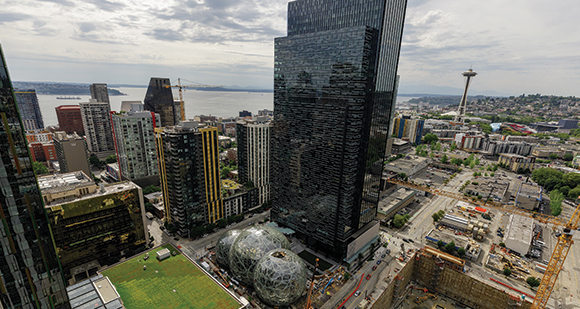
|
STEM
Skills training from tech giants like Amazon is much more than mere
window dressing. It’s a door to everyone’s future.
|
|
 |
INVESTMENT PROFILE: PUERTO RICO
A look at three growing institutions tells you why.
|
|
Philippines
Singapore may have declared a moratorium on data center expansions,
but that doesn’t mean Singapore-based firms can’t continue expanding
elsewhere. Data center developer SpaceDC says it is working with JLL
to build a 72-MW, 43,000-sq.-m. (462,863-sq.-ft.) data center campus
called MNL1 in Cainta, part of Greater Manila. “The green data
center will be fully powered with renewable energy — wind,
geothermal — and is slated to open in 2022,” the company announced
earlier this month, calling the three-building development the
largest hyperscale data center campus in the Philippines. “The
Philippines ranks second in terms of data center growth in Southeast
Asia,” said SpaceDC CEO Darren Hawkin. “With only 47MW of available
capacity in the country it is a dramatically underserved market. We
are excited to be a first mover in a new market where we see our
customers are investing heavily.”
Arizona
XNRGY, one of the largest custom air-handling manufacturers in North
America, plans to build a new advanced manufacturing facility and
headquarters in the Greater Phoenix area that will pour $300 million
into 1 million sq. ft. and employ 900. According to the Arizona
Commerce Authority, the investment comes at the same time the
company is expanding to 250,000 sq. ft. in Montréal, and expands the
company’s overall manufacturing footprint by a factor of eight as
demand increases for the company’s climate technologies. Among other
sectors, the company is aiming to serve the growing cooling and
sustainability needs of growing data centers — a hot sector in
Greater Phoenix, among other places, as Arizona claims the
fifth-largest data center inventory in the nation. “XNRGY wants to
be part of the solution to cool hyper-scale data centers without
millions of gallons of water a day,” said the Commerce Authority.
|
|
  |

|
BUSINESS CLIMATE OVERVIEW
In key state rankings and cost of living, the Sunflower State shines
brightest.
|
|
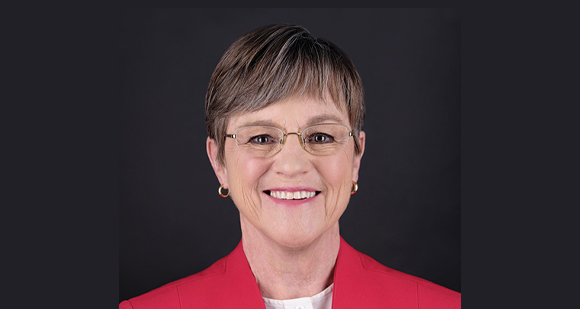 |
GOVERNOR Q&A
Governor Laura Kelly announced the state’s second record-breaking
year in a row, as companies invested in $3.7 billion worth of
projects in 2021.
|
|
|
SITE
SELECTION RECOMMENDS
|
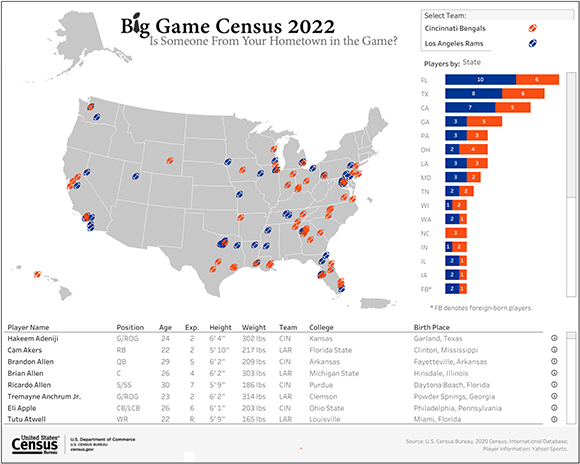
|
|
|
Graphic courtesy of U.S. Census Bureau |
|
|
The U.S. Census Bureau is not averse to having a little fun,
especially in the lead-up to the “big game” this Sunday in Los
Angeles. This week it decided to offer us some insights into snack foods, NFL-affiliated metro areas and
where all the players on both the Cincinnati Bengals and Los Angeles
Rams were born. Among the findings:
- According to 2019 County Business Patterns (CBP) data, the state
with the greatest number of snack food manufacturing
establishments was California with 141, followed by Texas (59)
and Pennsylvania (56). According to the 2020-2019 Annual Survey
of Manufactures (ASM), snack food manufacturing establishments
had sales of $40.4 billion in 2020 and $39.6 billion in sales in
2019.
- California (No. 3) and Texas (No. 2) are also in the top three
when it comes to producing players in the game, with 12 and 14
players respectively. But the overall leader is Florida with 16.
- Los Angeles-Long Beach-Anaheim, California, is the nation’s
second-largest metro area with a population of 13,200,998. The
Cincinnati, Ohio-Kentucky-Indiana, metro area is No. 30 with
2,256,884. The smallest of the 32 NFL metros? You guessed right
if you picked Green Bay, No. 158 in the country with a
population of 328,268.
|
|
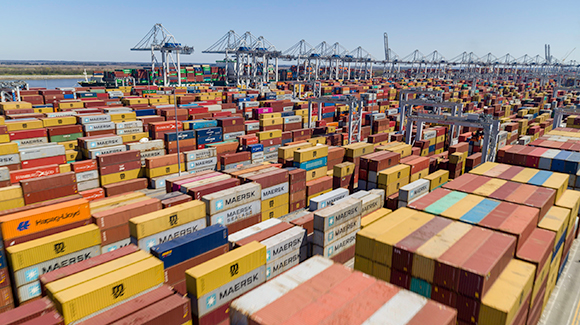
|
Photo courtesy of the Georgia Ports Authority
|
|
The Port of Savannah handled a record 479,700 TEUs of cargo in
January, the 18th straight month the port’s Garden City Terminal
(pictured) has set a monthly record. “The steps we have taken to add
capacity have broken the logjam in global logistics for our
customers and created jobs throughout the supply chain” said Georgia
Ports Authority (GPA) Executive Director Griff Lynch in a GPA
release yesterday. Some of that cargo is temporarily flowing to five
pop-up container yards the GPA has arranged for around the
Southeast, including the newest one at the CCX Yard in Rocky Mount,
North Carolina, owned and operated by CSX. Four other flexible
pop-up facilities are located near manufacturing and distribution
centers in Savannah, Atlanta, Statesboro and the the GPA’s
Appalachian Regional Port in Murray County in northwest Georgia.
According to the GPA, over the past year and a half, the Port of
Savannah has grown its container volumes by 1.2 million TEUs. In
March, GPA will add 500,000 TEUs of annual capacity, growing to a
total of 1.6 million TEUs of new capacity by June — a 25% increase
from Savannah’s previous container capacity. The most recent
economic impact study by the University of Georgia’s Terry College
of Business finds that port activity supports one job for every 10
TEUs moved each year. GPA alone grew by 145 employees last year.
|
|
|
|

